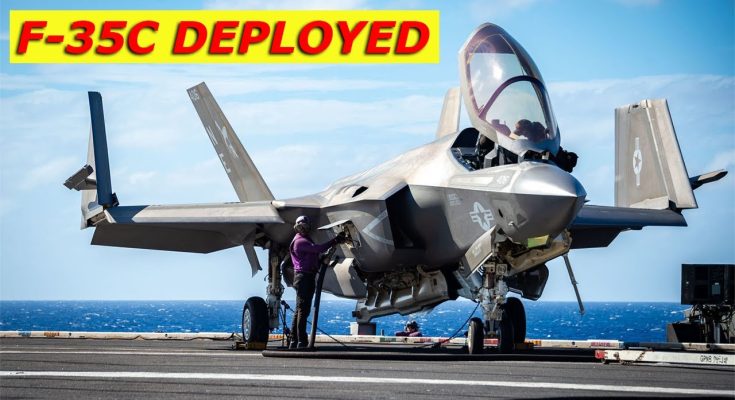The U.S. Navy has taken a historic step by deploying the F-35C, the carrier-based variant of the fifth-generation fighter jet, in the Red Sea for the first time. This milestone not only marks a significant development in the U.S. Navy’s operations but also highlights the evolving nature of modern warfare. The deployment of the F-35C in this strategically important region signals a new era of naval power projection, with the U.S. Navy showcasing its commitment to maintaining a technological edge in a rapidly changing global security environment.
The F-35C: A Game-Changer for Naval Aviation
The F-35C, developed by Lockheed Martin, is the Navy’s latest and most advanced multirole stealth fighter. Designed specifically for carrier operations, it is an evolution of the F-35 program, which includes variants for the Air Force (F-35A) and Marine Corps (F-35B). The F-35C is equipped with larger wings and enhanced landing gear, making it suitable for the demanding conditions of aircraft carriers. It also features advanced avionics, sensors, and a stealthy design that makes it virtually undetectable by enemy radar.
With its cutting-edge stealth capabilities, advanced sensors, and long-range strike potential, the F-35C is designed to dominate the skies in both air-to-air and air-to-ground combat scenarios. Its ability to conduct precision strikes, gather intelligence, and conduct surveillance while remaining virtually invisible to enemy radar represents a transformative leap in naval warfare. The deployment of the F-35C in the Red Sea is a clear indication of the Navy’s confidence in the jet’s ability to carry out a wide range of complex missions.
The Red Sea: A Strategic Hotspot
The Red Sea is a vital waterway that connects the Mediterranean Sea to the Indian Ocean through the Suez Canal, making it an essential route for global trade and military operations. The region has become increasingly important as global powers look to assert influence over the Middle East, Africa, and Asia. Tensions with regional adversaries, such as Iran, as well as ongoing conflicts in Yemen and other parts of the Arabian Peninsula, make the Red Sea a focal point for military operations.
The U.S. Navy’s decision to deploy the F-35C to the Red Sea is a response to these increasing strategic challenges. By positioning one of its most advanced aircraft in this region, the U.S. is signaling its readiness to respond quickly and decisively to any threats or instability in the area. The ability of the F-35C to operate from aircraft carriers provides the U.S. with an unmatched level of flexibility in projecting power and maintaining a persistent presence in one of the most volatile regions in the world.
The Role of the F-35C in Modern Warfare
The deployment of the F-35C in the Red Sea is not just about the aircraft’s technological superiority; it is also about the changing nature of modern warfare. The F-35C is part of a broader shift toward a more integrated, data-driven approach to military operations. The aircraft’s advanced sensors, network capabilities, and stealth features allow it to operate in highly contested environments, gathering critical intelligence, coordinating with other assets, and conducting precision strikes—all while minimizing the risk of detection and retaliation.
The F-35C also plays a crucial role in the U.S. Navy’s emphasis on “distributed lethality,” a concept aimed at ensuring the Navy’s ability to project force from multiple platforms in a highly coordinated manner. By operating from aircraft carriers, the F-35C enhances the Navy’s ability to strike targets across vast distances, maintain air superiority, and provide critical intelligence to commanders on the ground and at sea. This flexibility is a cornerstone of modern naval strategy and ensures that the U.S. Navy remains a dominant force in the world’s oceans.
A New Era of Naval Power Projection
The deployment of the F-35C in the Red Sea marks a turning point in the U.S. Navy’s ability to project power globally. It demonstrates the Navy’s ongoing efforts to modernize its fleet and integrate cutting-edge technologies into its operations. As the F-35C becomes a central component of the Navy’s air wing, its role will expand beyond traditional air superiority and strike missions. It will play a key role in intelligence gathering, electronic warfare, and integrated operations with other military branches and allies.
This deployment also underscores the importance of maintaining a technological edge in modern warfare. The F-35C, with its advanced stealth capabilities and versatile mission profile, is poised to be a game-changer in the U.S. Navy’s ability to adapt to evolving threats. Whether in the Red Sea, the South China Sea, or other global hot spots, the F-35C’s capabilities will ensure that the U.S. Navy remains a powerful and flexible force in modern warfare.
Conclusion
The first deployment of the F-35C in the Red Sea represents a milestone in the U.S. Navy’s commitment to maintaining dominance in the modern battlespace. With its stealth capabilities, advanced avionics, and versatility, the F-35C is reshaping the future of naval aviation and warfare. The aircraft’s presence in the Red Sea serves as a powerful symbol of the Navy’s ability to project force and maintain security in one of the world’s most critical regions. As the future of modern warfare continues to evolve, the F-35C will undoubtedly play a central role in the U.S. Navy’s strategy for years to come.



